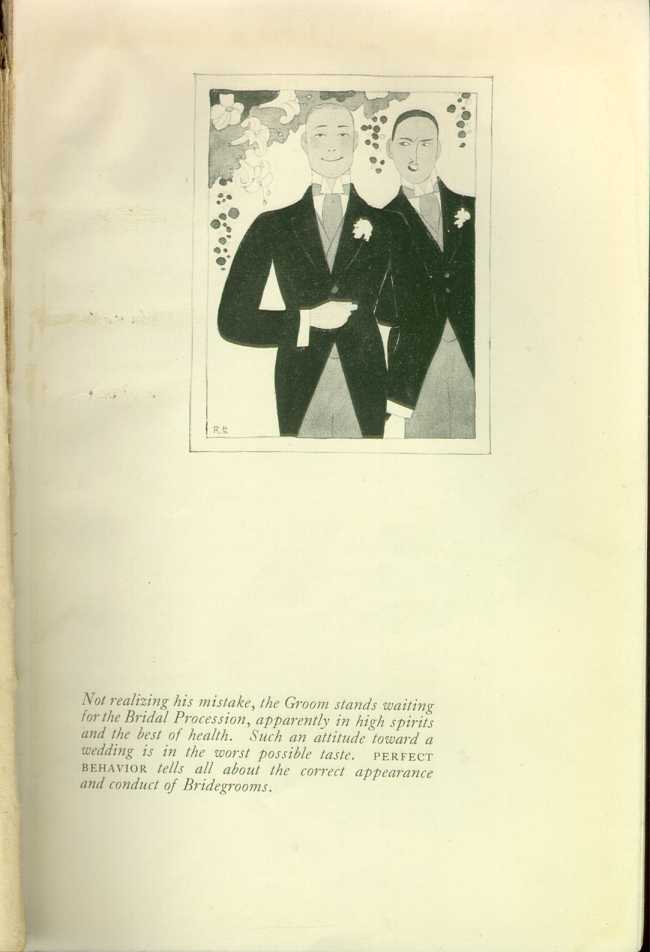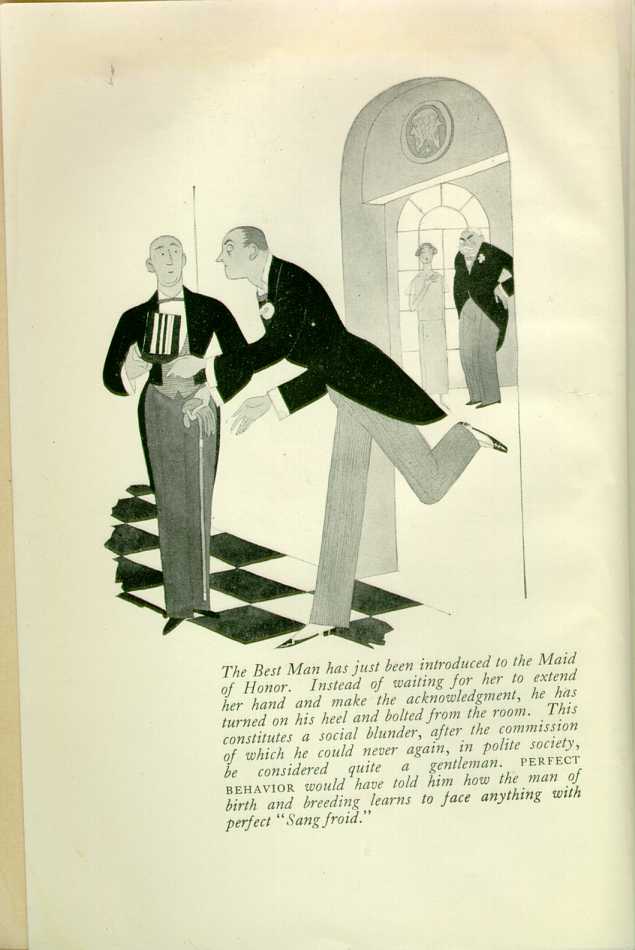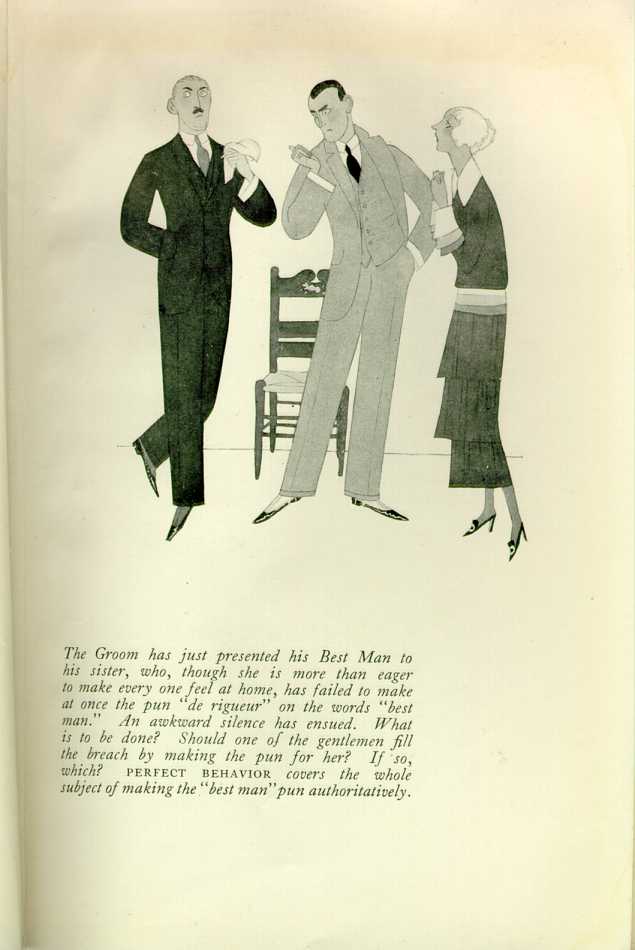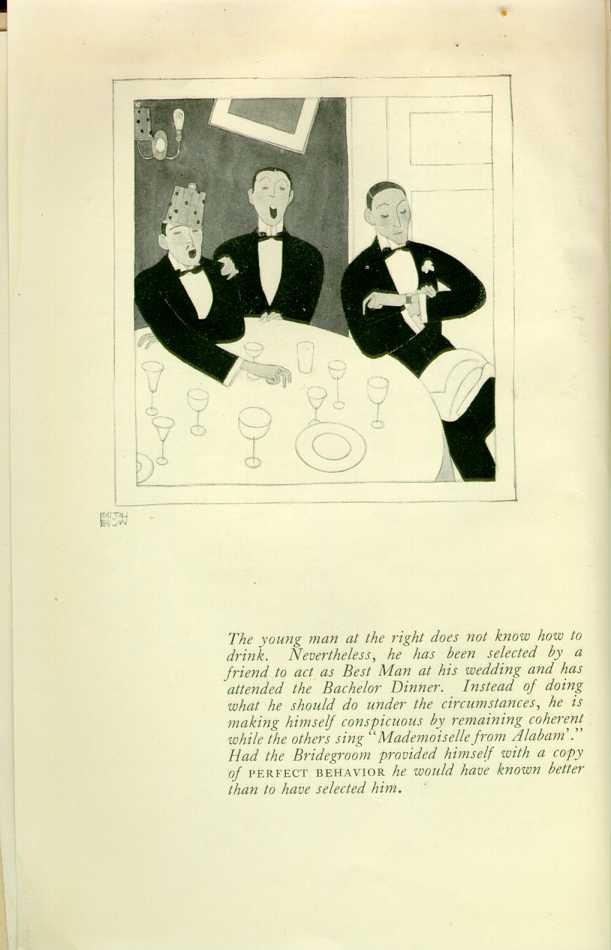THE ETIQUETTE OF TELEPHONING
ON Thursday morning, therefore, you should go to a public
telephone-booth in order to call the young lady's house. The etiquette
of telephoning is quite important and many otherwise perfectly well-bred
people often make themselves conspicuous because they do not know the
correct procedure in using this modern but almost indispensable
invention. Upon entering the telephone-booth, which is located, say, in
some drug store, you remove the receiver from the hook and deposit the
requisite coin in the coin box. After an interval of some minutes a
young lady (referred to as "Central") will ask for your "Number,
please." Suppose, for example, that you wish to get Bryant 4310. Remove
your hat politely and speak that number into the mouthpiece. "Central"
will then say, "Rhinelander 4310." To which you reply, "No, Central—Bryant
4310." Central then says, "I beg your pardon—Bryant 4310," to which you
reply, "Yes, please." In a few minutes
a voice at the other end of the line says, "Hello," to which you answer,
"Is Miss Doe at home?" The voice then says, "Who?" You say, "Miss Doe,
please—Miss Dorothy Doe." You then hear the following, "Wait a minute.
Say, Charlie, is they anybody works around here by the name of Doe?
There's a guy wants to talk to a Miss Doe. Here—you answer it." Another
voice then says, "Hello." You reply "Hello." He says, "What do you
want?" You reply, "I wish to speak to Miss Dorothy Doe." He says, "What
department does she work in?" You reply, "Is this the residence of J.
Franklin Doe, President of the First National Bank?" He says, "Wait a
minute." You wait a minute. You wait several. Another voice—a new
voice says-"Hello." You reply "Hello." He says, "Give me Stuyvesant
8864." You say, "But I'm trying to get Miss Doe—Miss Dorothy Doe." He
says, "Who?" You say, "Is this the residence of—" He says, "Naw—this
is Goebel Brothers, Wholesale Grocers—what number do you want?" You
say, "Bryant
4310." He says, "Well, this is Rhinelander 4310." You then hang up the
receiver and count twenty. The telephone bell then rings, and inasmuch
as you are the only person near the phone you take up the receiver and
say, "Hello." A female voice, says, "Hello, dearie—don't you know who
this is?" You say, politely but firmly, "No." She says, "Guess!" You
guess "Mrs. Warren G. Harding." She says, "No. This is Ethel. Is Walter
there?" You reply, "Walter?" She says, "Ask him to come to the phone,
will you? He lives up-stairs over the drug store. Just yell 'Walter' at
the third door down the hall. Tell him Ethyl wants to speak to him—no,
wait—tell him it's Madge." Being a gentleman, you comply with the
lady's request. After bringing Walter to the phone, you obligingly wait
for some twenty minutes while he converses with Ethel—no, Madge. When
he has finished, you once more enter the booth and tell "Central" you
want Bryant 4310. After a few minutes "Central" says, "What number did
you call?" You say patiently, "Bryant 4310."
She replies, "Bryant 4310 has been changed to Schuyler 6372." You ask
for Schuyler 6372. Finally a woman's voice says, "Yass." You say, "Is
Miss Doe in?" She replies, "Yass." You say, "May I speak to her?" She
says, "Who?" You reply, "You said Miss Doe was at home, didn't you?" She
replies, "Yass." You say, "Well, may I speak to her?" The voice says,
"Who?" You shout, "Miss Doe." The voice says, "She ban out." You
shriek, "Oh, go to hell!" and assuming a graceful, easy position in the
booth, you proceed to tear the telephone from the wall. Later on in the
day, when you have two or three hours of spare time, you can telephone
Miss Doe again and arrange for the evening's visit.



